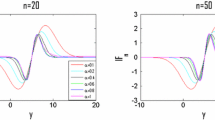Abstract
The Strauss process is a point process with unnormalized density with respect to a Poisson point process of rate \( \lambda \), where each pair of points within a specified distance r of each other contributes a factor \(\gamma \in [0, 1]\) to the density. Basic acceptance-rejection works spectacularly poorly for this problem, which is why several other perfect simulation methods have been developed. These methods, however, also work poorly for reasonably large values of \(\lambda \). Recursive Acceptance Rejection Stitching is a new method that works much faster, allowing the simulation of point processes with values of \(\lambda \) much larger than ever before.
Access this chapter
Tax calculation will be finalised at checkout
Purchases are for personal use only
Similar content being viewed by others
References
Devroye, L.: Non-uniform Random Variate Generation. Springer, Berlin (1986)
Glass, L., Tobler, W.: Uniform distribution of objects in a homogeneous field: Cities on a plain. Nature 233, 67–68 (1971)
Hörmann, W., Leydold, J., Derflinger, G.: Automatic Nonuniform Random Variate Generation. Springer, Berlin (2004)
Huber, M.: Spatial point processes. In: Brooks, S., Gelman, A., Jones, G., Meng, X. (eds.) Handbook of MCMC, pp. 227–252. Chapman & Hall/CRC Press (2011)
Huber, M.: Spatial birth-death swap chains. Bernoulli 18(3), 1031–1041 (2012). ArXiv:1006.5934
Huber, M.L.: Perfect Simulation. No. 148 in Chapman & Hall/CRC Monographs on Statistics & Applied Probability. CRC Press (2015)
Jerrum, M., Guo, H.: Perfect simulation of the hard disks model by partial rejection sampling. Annales de l’Institut Henri Poincaré D (AIHPD) (2019)
Kelly, F., Ripley, B.D.: A note on Srauss’s model for clustering. Biometrika 63(2) (1976)
Kendall, W.S.: Perfect simulation for the area-interaction point process. In: Proceedings of the Symposium on Probability Towards the Year 2000 (1995)
Kendall, W.S., Møller, J.: Perfect simulation using dominating processes on ordered spaces, with application to locally stable point processes. Adv. Appl. Prob. 32, 844–865 (2000)
Kendall, W.S., Thönnes, E.: Perfect simulation in stochastic geometry. Pattern Recognit. 32, 1569–1586 (1999)
P. L’Ecuyer. Random number generation. In: Gentle, J.E., Haerdle, W., Mori, Y. (eds.) Handbook of Computational Statistics, 2nd edn. pp. 35–71. Springer, Berlin (2012)
von Neumann, J.: Various techniques used in connection with random digits. In: Monte Carlo Method, Applied Mathematics Series 12. National Bureau of Standards, Washington, D.C. (1951)
Preston, C.: Spatial birth-and-death processes. Bull. Inst. Int. Stat. 46(2), 371–391 (1977)
Propp, J.G., Wilson, D.B.: Exact sampling with coupled Markov chains and applications to statistical mechanics. Random Struct. Algorithms 9(1–2), 223–252 (1996)
Strand, L.: A model for stand growth. In: IUFRO Third Conference Advisory Group of Forest Statisticians, vol. 72, p. 3. INRA, Institut National de la Recherche Agronomique Paris (1972)
Strauss, D.J.: A model for clustering. Biometrika 63, 467–475 (1975)
Author information
Authors and Affiliations
Corresponding author
Editor information
Editors and Affiliations
Rights and permissions
Copyright information
© 2022 The Author(s), under exclusive license to Springer Nature Switzerland AG
About this paper
Cite this paper
Huber, M. (2022). Generating From the Strauss Process Using Stitching. In: Keller, A. (eds) Monte Carlo and Quasi-Monte Carlo Methods. MCQMC 2020. Springer Proceedings in Mathematics & Statistics, vol 387. Springer, Cham. https://doi.org/10.1007/978-3-030-98319-2_12
Download citation
DOI: https://doi.org/10.1007/978-3-030-98319-2_12
Published:
Publisher Name: Springer, Cham
Print ISBN: 978-3-030-98318-5
Online ISBN: 978-3-030-98319-2
eBook Packages: Mathematics and StatisticsMathematics and Statistics (R0)




